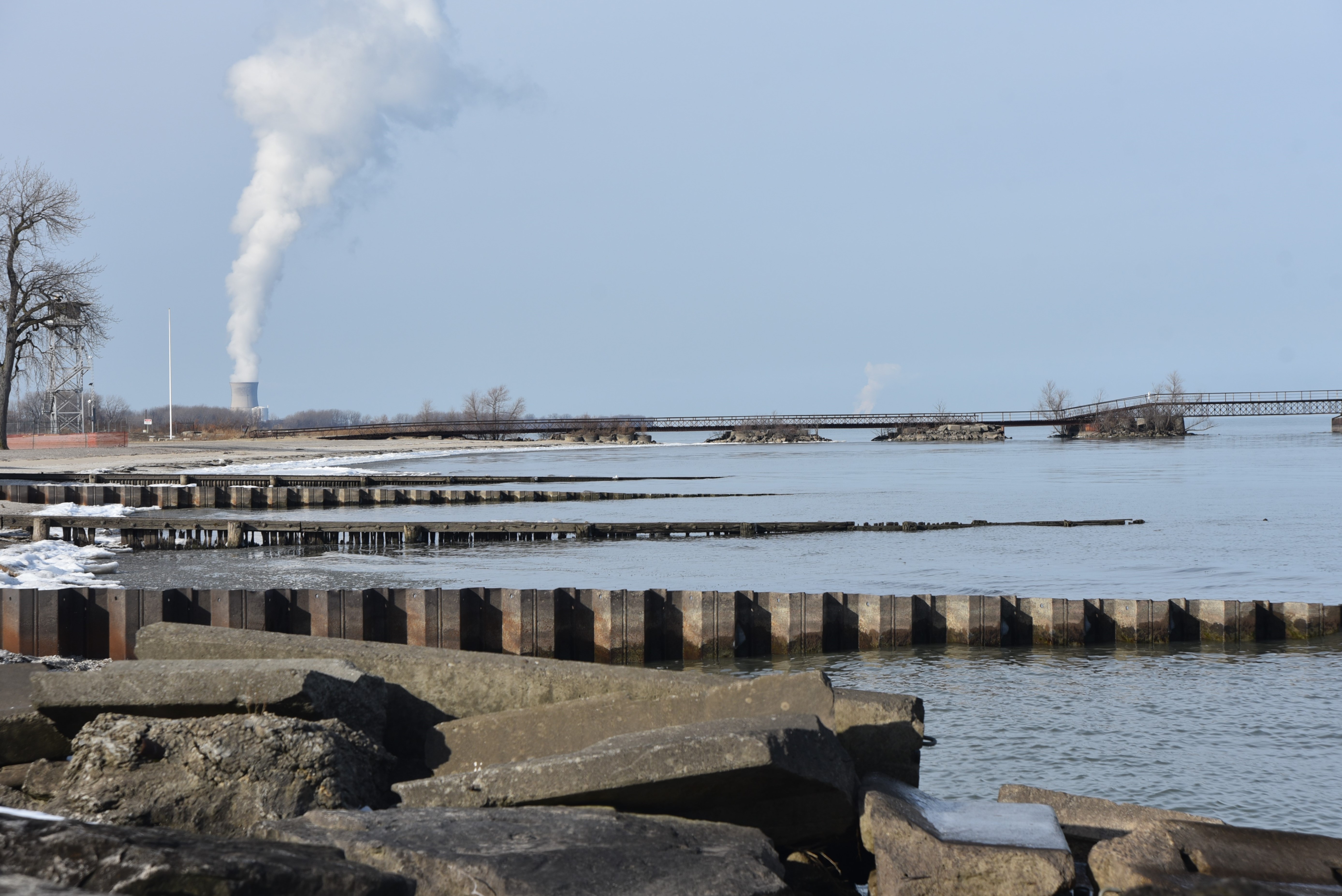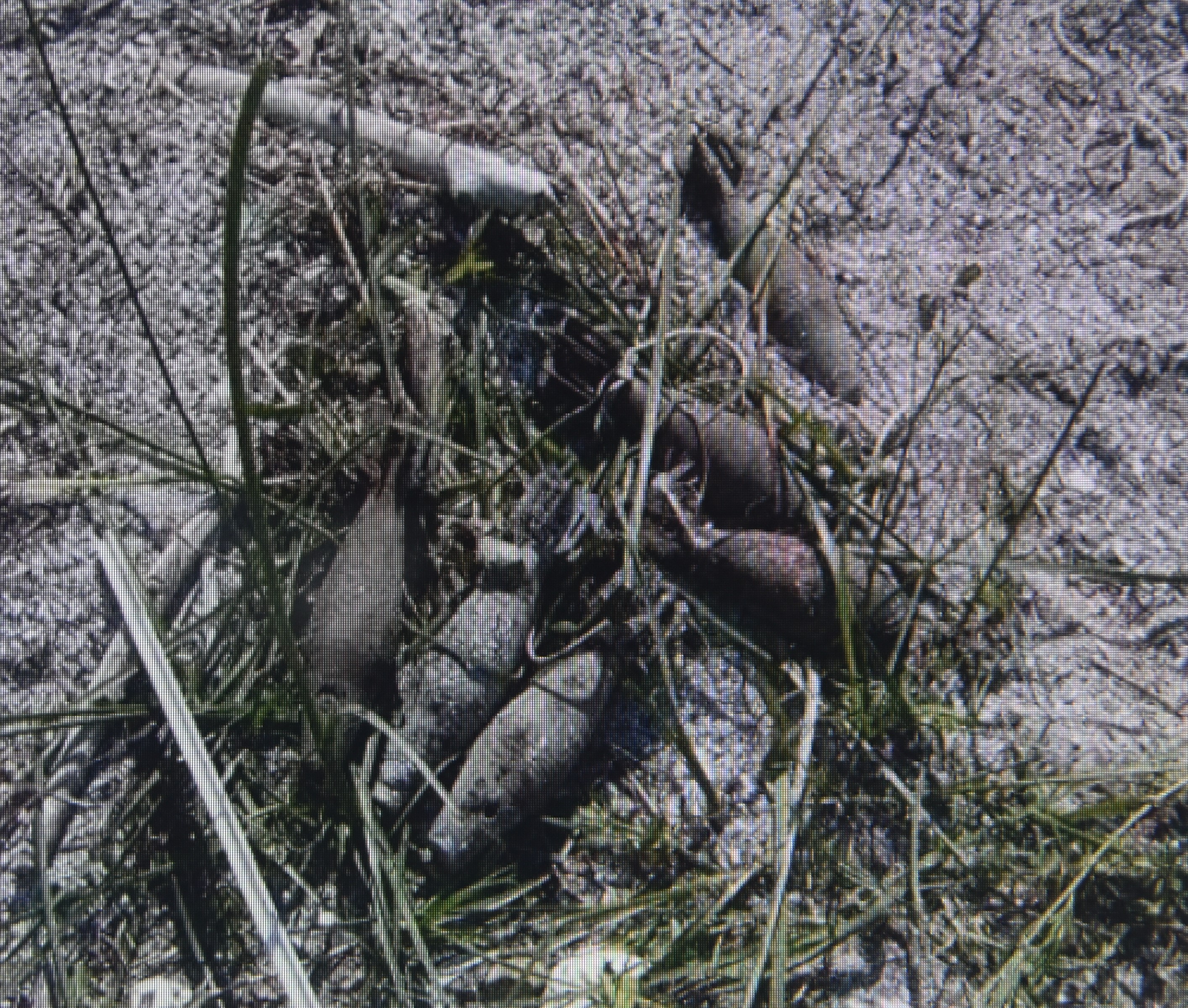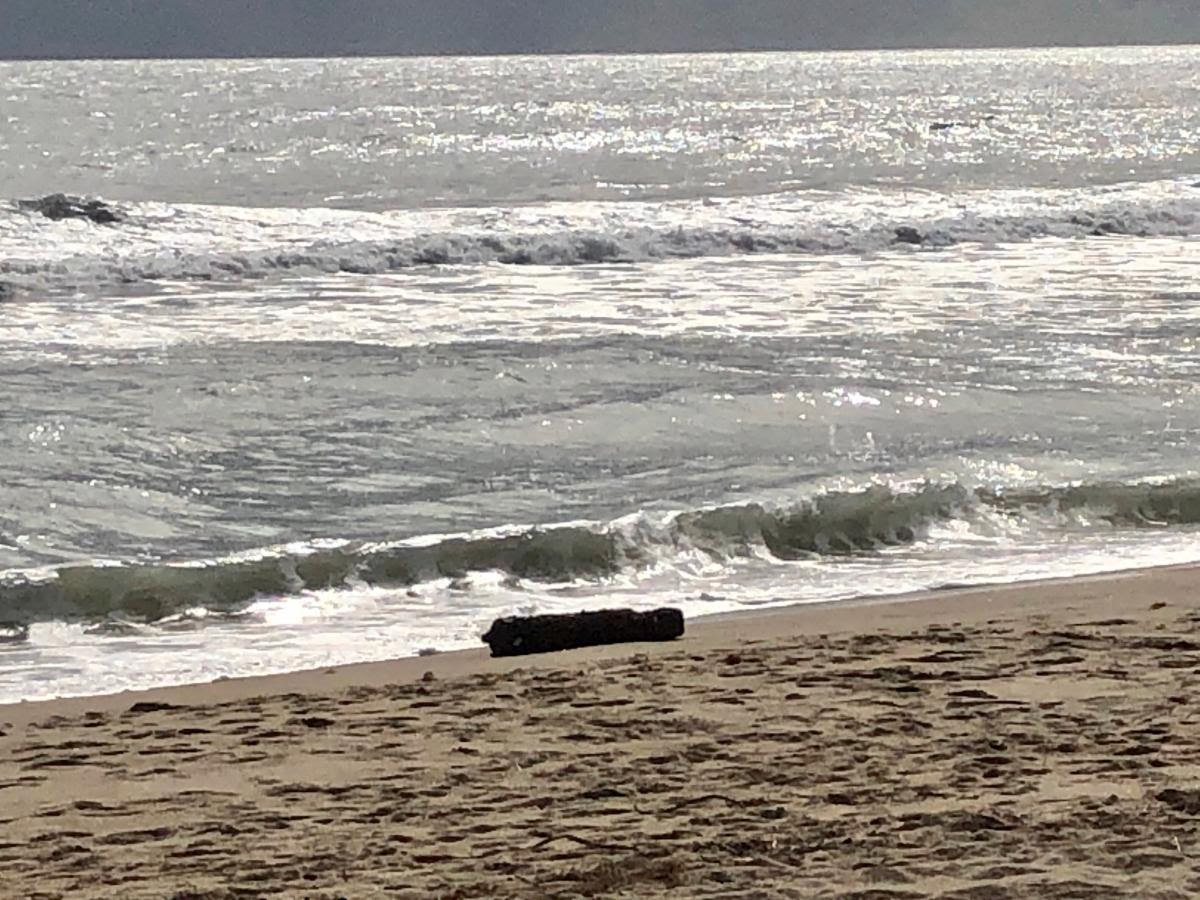
In 1991, a Lake Michigan fishing vessel crew netted an object they later deposited on a beach in Sheboygan, Wisconsin. It was subsequently identified as a fully-armed Sidewinder missile. While this is an extreme example of unexploded ordnance (UXO) pollution, it highlights the issue of old military munitions in the Great Lakes.
American defense operations have utilized thousands of sites for manufacturing, testing, training and disposing of weapons and munitions over the centuries. The Great Lakes were mostly spared, with the government opting for the eastern and western coastal regions instead.

A mounted Sidewinder missile. (Provided by U.S. Air Force)
Even so, there are more than a dozen sites in the lakes and on its shores that were historically used.
One Formerly Used Defense Site on western Lake Erie is home to a project which focuses on locating and mapping old military munitions – including some that could still be live. The results of the study will be used in planning future remediation of UXO sites which could pose a hazard to the public not just on Lake Erie, but at FUDS everywhere UXO are found in marine environments.
The U.S. military purchased nearly 2,000 acres of land on the lakeshore just west of Port Clinton in 1918. The Camp Perry Proving Ground, subsequently re-named Erie Army Depot also controlled 96,000 acres of the adjacent Lake Erie for use as an impact and safety zone for its firing range. For a half century, until 1965, the property and its lake range served as an air-defense artillery and aerial bombardment proving ground. The land and water which were part of EAD were subjected to millions of rounds of ammunition over the decades, though it received especially intense use during World War II. Between 1941 and 1946, according to a U.S. military report, 70% of all mobile arms used by the U.S. and provided to Allied forces during the war were tested at the EAD.
From 1953 to 1963, the Locust Point Anti-Aircraft Firing Area was just west of the Erie Army Depot. That location is currently the site of the Davis Besse Nuclear Power Station.

The former Erie Arms Depot is now the Lake Erie Business Park. (Photo Credit: James Proffitt)
Many impacts over the years
“They were using (Erie Army Depot) as a firing range way back in the ‘40s, and there are several million rounds out there,” said Scott Jenkins, who worked for the Marine Physical Laboratory at the Scripps Institution of Oceanography when the Vortex Lattice UXO Mobility Model Integration report was written. “The bottom line is some of those rounds are still live and others are just fragments of rounds. A lot of them are embedded in that Great Lakes clay formation beneath the soft sediments, so most of them are entombed permanently.”
Jenkins was one of the scientists who worked on the study assessing UXO at the site. He said despite the fact that most of the munitions are buried in the clay, sand and muck, they do regularly make appearances. Published in 2015, the study used a series of complex equations, lake-related weather data and historical military records to estimate how projectiles landed in the lake and where they were likely to currently rest.
The study found that 97.5% of the impacts were deep, about 23-47 inches, and would likely prevent them from moving in the future. The other 2.5% were shallow, as close to the surface as about 6 inches. The study showed the shallow entries, over a 28-year period, would eventually average a burial depth of about 10 inches. Due to weather, including waves and ice, about 4.5% of those would become partially exposed and release from burial.
Over time, UXO have consistently appeared on and near beach areas in the vicinity of the Camp Perry Joint Training Center, an Ohio National Guard facility adjacent to the former EAD. Since its use by the Department of Defense ended in the 1960s, the land has been turned over to private development including residential areas, private marsh hunting land and an industrial park. A private defense contractor, Ares, Inc., still utilizes a portion of the former EAD and the lake to develop and test-fire weapons systems.
According to HydroGeologic’s Remedial Action Plan Report finished in 2019, more than 13,000 UXO were recovered during surface removal operations at or in the vicinity of Camp Perry and EAD from 1992 through 2011. Most of those UXO are found in the shallowest water near land and on land near the water.

60-millimeter mortars recovered from Lake Erie. (Provided by USACE)
Congress created FUDS program in the mid-1980s
After Congress created the FUDS program, which the U.S. Army administers, the U.S. Army Corps of Engineers was tasked with its execution. The program covers a wide range of remediation projects including demolition of buildings, cleaning up hazardous, radioactive and toxic waste, and removing munitions and explosives which pose a hazard to people. USACE has identified in excess of 15,000 properties which had been used by the military across the U.S. and territories, including the Lake Erie site in Port Clinton.
Of those, about 5,400 were included in a list to be cleaned up. And of that number, about 3,700 have been completed. Most of the listed FUDS were locations where live munitions were never stored, fired or disposed. The list includes POW camps, naval reserve centers, radio and radar stations, old Nike missile silos and, interestingly, an abandoned weather rocket station located at the tip of the Keweenaw Peninsula.
The National Priorities List is the list of national priorities among the known or threatened releases of hazardous substances, pollutants or contaminants. Great Lakes Now did not find any of the Great Lakes FUDS also included on the NPL, also known as U.S. EPA Superfund sites.
Examples of FUDS evaluated for their UXO histories include the former Camp Claybank on Lake Michigan, south of Ludington, Michigan; Hat Island in Lake Michigan; the former Camp Logan just north of Waukegon, Illinois; and the former Edithton Beach Training Center in Kenosha, Wisconsin.
While the majority of the FUDS in the Great Lakes reverted to civilian control and development long ago or had never been the subject of safety concerns to begin with, a few including the Port Clinton site were locations where UXO was an issue.
In a 2006 survey and target recovery operation on Lake Erie, teams worked to map and investigate a small number of metallic anomalies found, including on the Toussaint River channel and on the reefs nearby. While divers located a large number of missing boat anchors, they also located plenty of UXO. Between Cone, Crib, Toussaint, Little Pickerel, Round and Flat Rock reefs, a dive team was provided 36 targets to investigate. Divers recovered 10 155-millimeter projectiles, three 105-millimeter projectiles, one 90-millimeter projectile, two 75-millimeter projectiles and one 4.2-inch mortar.
Since 1965, at least 24 people in the U.S. have been killed by UXO, including four children in two incidents and eight members of a fishing trawler that netted a live torpedo off the North Carolina coast. At least 22 people have been seriously injured.

A live 100-pound aerial bomb washed ashore in October at Cape Hatteras Lighthouse Beach. (Provided by National Park Service)
UXO appears regularly on beaches around Camp Perry
“When you get ice in the winter, the ice sheets form keels, and as the northwest winds blow, it forces the ice to move shoreward. That’s when the ice keels begin gouging the bottom and they will gouge out the UXO rounds and push them up onshore,” Jenkins explained. “And as the lake levels rise and fall – and they do significantly – that will expose some of those rounds that were pushed ashore by the ice. That’s when people find them on the beach and become all upset.”
But not everyone becomes upset when finding old military munitions. For some folks, it was ho-hum, like for Stan Cutcher, a retired commercial fisherman who for decades set trap nets along the shoreline to haul in yellow perch, white perch, white bass, freshwater drum and other fish.
“I’m not sure what they were. Some of them were small, we got them, and there were a few times we got some big ones,” he said. “I don’t know how they got down toward us. But I know when I used to fish when I was netting for Port Clinton, I fished right out of the Toussaint, a little east of it, and they would run me out if I got in there too early because they were shooting, you know, and it was right on the corner of the range.”
Cutcher said when fishermen pulled up munitions in their nets, they’d hang onto them for a bit.
“We didn’t throw them back in the water,” he said. “We took them in, and we’d leave them, lay there on the beach, and we’d call the sheriff and whoever it was, they’d come down and get them. It was a good thing because I was scared one of my guys would get hurt and I didn’t want that to happen.”
Over the years, UXO sometimes made personal appearances on recreational fishing boats too. One Port Clinton News Herald article published in 2009 featured an angler who pulled a mortar shell from the lake with his anchor after he finished fishing.
The Mobility Model report indicates the Toussaint River channel, 3 miles northwest of Camp Perry, has produced UXO on a regular basis during dredging to benefit the sportfishing boats which use it. In 1992, a 106-millimeter UXO jammed in a dredge just before the dredging operations were completed. Three years later, a controlled dredging experiment recovered 37 items in a single pass through the channel. Over the years, the report says, many commercial fishermen who had pulled up UXO with their nets dropped them overboard in Toussaint River marinas while unloading fish.
Studies on the munitions found on shore indicate that constant erosion exposes ordnance, but that the primary transport mechanism is Lake Erie ice. “Munitions present at the top of the sediment can be frozen into ice packs. Change in water temperatures and water levels create ice flows, moving munitions to the shoreline. During the spring, the ice thaws, leaving munitions on the surface of the shore,” one report reads.
Read more Lake Erie news on Great Lakes Now:
Got Pike? Huron, Michigan, Ontario, Superior, Yes. Erie, not so much.
Oldest Coast Guard cutter with smallest crew and largest Great Lakes responsibility needs replacing
Family-owned fishing businesses displaced by waterfront developments on Great Lakes
Lake Erie’s Camp Perry a Test Site for UXO Mapping
The USACE selected Camp Perry after considering 25 FUDS located in eight states and Puerto Rico, according to the Mobility Model report. The Lake Erie site was chosen for multiple reasons, including an extensive history of UXO interaction with human activities, readily available environmental data, and information available from previous sampling and beach clearance activities.
The report also indicates the presence of ice effects was a major plus. Those effects will allow scientists to use Lake Erie data to prepare for the same types of activities at Arctic beach sites which are included in the FUDS evaluation and possible clean-up efforts. Alaska currently has more than 50 such sites in the water and on or near its coasts.
Sea Wulf is a one-of-a-kind contraption
When the USACE wants to find UXO, its go-to guy for determining exactly where they are located is Brian Herridge, who operates Chaska, Minnesota-based 3Dgeophysics. He and a survey crew recently spent about two months at a marina near the Lake Erie site.
“We make very high-resolution, very accurate maps which we turn over to the government. They can use those to recover the munitions,” he explained. “We’re the only ones that do this, the only ones that map in the water.”
When Great Lakes Now met Herridge, he was at Beef Creek Marina working on Sea Wulf, a 22-foot aluminum Thunderjet boat that looks like nothing else on Lake Erie. The vessel’s cabin is fitted with an array of computer screens and cables, and its hull is completely surrounded by long custom-made aluminum appendages.

Gassing up Sea Wulf. (Photo Credit: James Proffitt)
“That’s a metal detector back there, and there’s four coils in it, so we fly that by this elevator here. When it’s in the water it flies right along the bottom and there’s a guy inside that sees everything on a computer screen,” he explained. “We map all this on the front of the boat where we have a pressure transducer, so we can see where this is flying. The guy inside uses an elevator which allows it to go up and down along the bottom as we drive the boat.”
When operating, crews lower equipment into the water in front of the boat which captures data that is used to operate the 12-foot-wide wing at the rear of the boat. While cruising at 3 or 4 mph, an elevator moves the wing up and down in order to stay as close to the bottom as possible. The vessel can map in water as shallow as 3 feet and as deep as 20.
“There are so many electronics on this boat, I can’t really go through it all,” Herridge said. “Explaining how it works is probably beyond the scope of this conversation. But we make all this stuff, it’s all fabricated in our shop.”
Herridge said commercial side-scan sonar, metal detectors and other hi-tech components are utilized in a suite of technology unique to his company, meant to locate and map submerged and buried UXO down to exact, pinpoint locations. But his crew doesn’t dig up or move anything, they just locate it. Moving UXO is a job for others if it’s found that they’re a hazard to the public.
“They’re dangerous. People find them, they bring them to the authorities, they touch them, they haul them, they put them in their gardens as ornaments, all kinds of dumb things, so the government’s agreed to clean them up as they should,” Herridge said, going on to say that while few of the UXO are live, those that are more than likely contain high explosives.
“This is an important site, and they’ve been planning this for a while. But there are other sites on the Great Lakes,” he said. “We’ve worked on all the lakes.”
This is the first time 3Dgeophysics has worked on Lake Erie. Herridge said the search process is rigorous and begins prior to dawn when they launch Sea Wulf.
“Test on land, test on water,” he said. “There are known targets at known positions, and we fly those every day to make sure those targets at known positions show up at those positions. That proves the fidelity of the system. After that, we go survey. Sometimes we survey for eight minutes, other times eight hours, it all depends on the wind and how the weather changes and so on.”
Treasure hunters searching for booty draw attention
“We think munitions are buried treasure. We’ve worked a lot in Florida, and we’ve found cannons and stuff, but that’s the property of USACE when we find them. And who knows what treasures they may have found?” Herridge said. “We’ve found bombers, fighters with crew inside, wrecks and mystery stuff where nobody knows how it got there. We’ve found armaments from Japan on the Atlantic coast.
3Dgeophysics has been hired by law enforcement and the federal government to find items not for public discussion, according to Herridge, though he confirmed he has not yet been hired to locate Jimmy Hoffa.
Herridge said he is constantly hounded by curious people when they encounter his strange vessel.
“Every single day we get asked ‘What is it, what is it, what is it?’” he said. “Oftentimes I say, ‘Take a guess’ and no one ever guesses what it is. Even military guys, no one’s ever guessed.”
Anglers and boaters in the area are especially cooperative when they spot Sea Wulf heading their way, Herridge said, unless it’s a great fishing spot and we irritate people because we go back and forth, back and forth. Herridge said Sea Wulf gets stopped on the water frequently by the Navy, DNR agencies and the Coast Guard to find out what it is and what they’re doing.
Check out Great Lakes Now‘s videos on Lake Erie:
API key not valid. Please pass a valid API key.FUDS surround the Great Lakes, mostly safe
An example of a typical Great Lakes FUDS is located in portions of Wilderness State Park about a dozen miles west of Mackinaw City. Before it was WSP, it was Waugoshance Point Target. The Naval Air Station in Traverse City used the site as a target for high-altitude bombing practice and as a machine gun testing and practice during World War II. An abandoned lighthouse about 2 miles northwest of the western tip of Waugoshance Island was also used as a target.
The site was included in a FUDS list, though after thorough investigation and surveys it was determined the sites at Waugoshance did not require remediation.
“The USACE did not find any munitions or explosives of concern during the several investigations they conducted over the years,” said William Harmon, a project manager with the Remediation and Redevelopment Division at Michigan Department of Environment, Great Lakes, and Energy. “Also, there’s never been any discovered or reported by the public or MDNR staff. The munitions debris found by USACE were remnants of 100-pound sand-filled practice bombs and miniature practice bombs.”
Harmon said only one UXO was found that originally had a signal cartridge and that it was similar to a single shotgun shell. Thus, Waugoshance Point, like many other FUDS, was deemed acceptably harmless. All the FUDS at WSP are remote with no roads or overnight camping and access by foot only.
Canada mirrors U.S. in UXO response
Of the 144 sites in Ontario which may have UXO, 22 sites are adjacent to or in the Great Lakes, according to emails from Andree-Anne Poulin with National Defence media relations. These sites are included in Canada’s UXO Legacy Sites Program, which is its version of FUDS specifically for UXO.
“As part of its commitment to ensure the public’s safety and address the presence of UXO sites in Canada, in 2005 the government of Canada created the UXOLSP,” Poulin said. “There are currently 827 sites across Canada where historical research shows that former military training and activities may have created UXO.”
Since 1927, 18 private citizens in Canada have been killed by UXO, with an additional 27 injured, according to Poulin. The last death was in 1997, and the last injury was in 2007.
“With the exception of one site all the UXO legacy sites identified within Canada’s Great Lakes were either bombing and gunnery schools, practice bombing ranges or aerial gunnery ranges,” Poulin said. “The one exception was the Dyers Bay Disposal Site, where in 1945 up to 1,000 tons of obsolete high explosive bombs were disposed of.”
Those bombs are currently sitting in about 400 feet of water, according to records.
“The UXO program team includes trained specialists who ensure that appropriate actions are taken efficiently and safely when UXO are found,” Poulin said.
UXO can pose more than explosive risks
While conventional munitions that have either been left in place after test firing or disposed of in water can be dangerous when encountered by people, they could also pose environmental contamination risks despite their ages.
“The DOD is not the bad guy here, they’ve never been the bad guy,” said James Barton, an independent defense analyst who co-authored Assessment of Lethal Chemical and Conventional Munitions in the Nation’s Waters for the National Center for Environmental Health. He’s also a retired boatswain’s mate. “This is a burden beyond their capacity, beyond their skill set, beyond their mandate and beyond their funding. It’s not in their mission statement – they’re just saddled with the leftovers of what it takes to fight and win wars.”
Barton said whatever the liability is for the DOD, the reality is that legacy munitions in marine environments is a problem for the nation as a whole. And it’s one that has received less attention and research than deserved.
According to his 2017 Assessment report, researchers were able to detect trace amounts of munitions constituents, which can include various chemical compounds, up to 3 meters from fully intact explosives-filled munitions that had been in saltwater since World War I. Trace amounts showed slightly smaller ranges for detection in a 2,000-pound WWII bomb submerged in saltwater. Such munitions on dry land would be classified as point source polluters, but not so for submerged munitions, Barton said. Accordingly, there is no significant history of ecological-based remediation of underwater munitions in the U.S.
“The reality is that unless it’s something that presents a public and immediate health threat, there will be no response. If you have something on a beach that washes up and your kid steps on it in shallow water you can call and expect an emergency response right now,” Barton said. “Local authorities will make phone calls, and the next thing you know you’ll have bomb threat guys showing up and they’re dealing with it.”
According to Barton, moving responsibility for UXO to non-DOD entities, such as the EPA, NOAA and other organizations, would better meet the needs of the American public and the environment as well as speed up the research and remediation processes needed.
“I want to see those munitions out of Lake Erie,” he said. “It’s not rocket science to get that stuff out of there.”

Looking west from Camp Perry toward Davis Besse Nuclear Power Station. This is the site of UXO surveys and remediation in Lake Erie. (Photo Credit: James Proffitt)
The future of UXO at Camp Perry
According to Jenkins, the likelihood of the legacy munitions in this area exploding are miniscule because they tend to degrade once the metal casings have been compromised.
“Once the water gets in there and mixes with the explosives materials it tends to denature the material, including the detonators,” he said. “The point though, is that it has the potential to explode and has a great potential for news stories, so it puts the Army and the Navy in a public relations dilemma. They don’t want to have to deal with it and it puts great pressure on the military to remediate these UXO fields.”
The reports generated on the Lake Erie UXO site for USACE indicate any environmental contamination from ordnance and munitions is likely minimal and does not pose hazards to humans or wildlife.
Herridge says 3Dgeophysics will return during the 2021 season for more Lake Erie UXO hunting in the same area.
USACE plans for the Lake Erie FUDS include clearance operations every three years until 2057 or until no more UXO appears on beach areas.
Authorities in the U.S. and Canada urge people who believe they have encountered any type of UXO or suspect an object to be UXO to follow simple safety guidelines of the three Rs: Recognize, Retreat, Report.
Featured image: Looking west from Camp Perry toward Davis Besse Nuclear Power Station. This is the site of UXO surveys and remediation in Lake Erie. (Photo Credit: James Proffitt)
1 Comment
-
Now that you’ve written about unexploded ordinance in the
Great Lakes, next you’ll want to address the history of improper
U.S. Coast Guard lead-acid battery disposal associated with navigation
aids in the Great Lakes.




